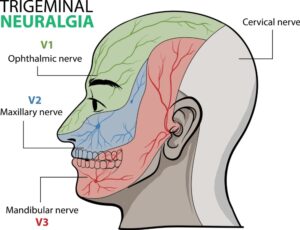WORDS LIM TECK CHOON
 FEATURED EXPERT FEATURED EXPERTDR SYED ABDULLAH AL-HADDAD Consultant Neurosurgeon Sunway Medical Centre |
Trigeminal neuralgia, also known as the ‘suicide disease’ or tic douloureux, is a rare and agonizing condition. While it is considered a rare disease due to its low occurrence among us, it has gained notoriety due to celebrities such as George Clooney and Salma Hayek revealing that they suffer from it.
It is more prevalent among women as well as people over the age of 50.
FACTS ABOUT TRIGERMINAL NEURALGIA
Causes a sudden, intense, stabbing, or electric shock-lain pain in the jaw or face
People with this disease can experience brief bouts of intense pain while carrying out daily activities that involve facial movements, such as chewing, talking, smiling, and more.
Dr Syed Abdullah Al-Haddad reveals that such painful episode can last from a few seconds to several minutes each time.
The pain is recurrent—one could experience a few to even a few hundred such attacks in a day!
He adds: “The intense, electric shock-like one-sided facial pain characteristic of this condition often leads to misinterpretation and misdiagnosis. Patients endure years of debilitating pain with one patient describing it as worse than labour pain.”
Commonly affects one side of the face
These bouts of pain commonly affect only one side of the face (the right side is more common). It is possible for both sides of the face to be affected, but such incidences are rare in an already rare disease.
It’s due to the disruption of the function of the trigeminal nerve
The trigeminal nerve transmits touch and pain sensations from our face and head to our brain.
There are 3 branches in the trigeminal nerve:
- The ophthalmic branch transmits nerve impulses to the top portion of our face, including our forehead.
- The maxillary branch transmits nerve impulses to the middle region of the face, including our cheeks, nostrils and upper lip.
- The mandibular branch transmits nerve impulses to the lower portion of our face, including the lower lip and jaw area.
Causes of trigeminal neuralgia
One of the more common causes is a blood vessel causing pressure on the trigeminal nerve.
Another common possible cause is multiple sclerosis, which causes the myelin sheath, the coating of nerve cells, to break down and put the person with multiple sclerosis at risk of developing trigeminal neuralgia.
Other possible causes include the presence of a tumour or lesion that compresses the nerves and damage to the trigeminal nerve due to surgery, stroke, or injury.
However, it is also possible for some cases of trigeminal neuralgia to have no specific identifiable cause.
It is often misdiagnosed
Due to how it is often misdiagnosed, trigeminal neuralgia can cause those affected to live with the pain for a long time. Dr Syed Abdullah Al-Haddad shares that one of his patients had one whole side of his teeth taken out due to his condition being misdiagnosed as dental pain.
Leaves a profound impact on the lives of those affected by this disease
The disease can make it difficult for those affected to perform daily activities like eating and talking as well as affect their mental health and relationships with their loved ones.
Dr Syed Abdullah Al-Haddad adds: “As they endure the intense pain, some patients decide to stop talking or even living a normal life. The symptoms can also interfere with their ability to work, impact relationships as some believe that sufferers are ‘mad’ or exaggerating their pain and lead to depression and sleep problems.”
DIAGNOSING THE DISEASE
According to Syed Abdullah Al-Haddad, the biggest challenge here is getting an accurate diagnosis.
Frequently, the condition is misdiagnosed as dental problems or issues related to the ear, nose, and throat first.
This is why it is crucial for doctors to listen to their patient’s symptoms and understand the characteristic features of the pain. The pain often described by patients is crucial and can be a sign of the disease.
Trigeminal neuralgia is diagnosed through a combination of patient-reported symptoms as well as a thorough physical examination and a magnetic resonance imaging (MRI) scan to rule out other potential causes such as multiple sclerosis or tumours.
TREATMENT
Treatment options include medications to block pain signals and surgical methods such as stereotactic radiosurgery.
The latter is a non-invasive procedure that delivers focused radiation to the trigeminal nerve root, reducing pain signals with a shorter recovery time and surgery to relieve pressure on the trigeminal nerve.
BE AWARE OF THIS DISEASE
Dr Syed Abdullah Al-Haddad tells us: “With trigeminal neuralgia often being misdiagnosed, it is important for rare diseases such as this one to not only be in the minds of neurologists but all healthcare professionals from general physicians, dental, ENT surgeons to the public alike so these patients can get the help they need and do not need to suffer any longer in silence.”








